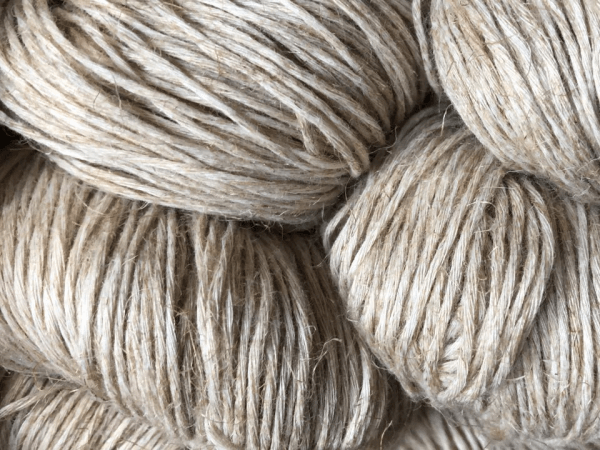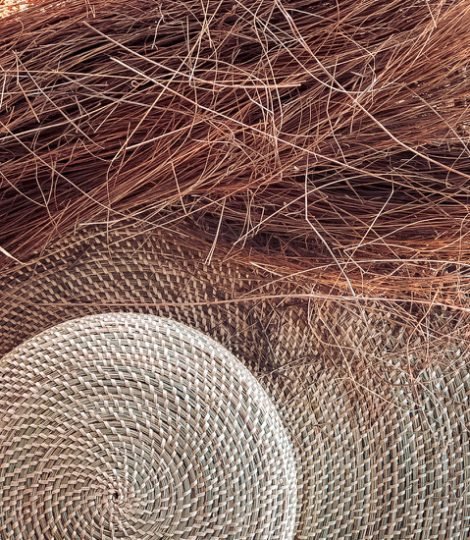NATURAL VEGETABLE FIBERS
Bamboo
Bamboo is a natural fiber from a pure, ecological, soft, UV repellent, antibacterial, absorbent, and comfortable cellulose, with high durability, stability, and tenacity. It comes from Northeast of Argentina.
Bamboo stick has a high ecological value as it comes from crops with renewable short cycles without harming the forest heritage. It is also 100% biodegradable and regenerates naturally and easily. The bamboo fiber offers a natural shine, which is equal to the silk shine. This fiber also has the power to regulate body temperature.
Its high resistance allows to knit the fibers together easily or by mixing them with other natural fibers. The usage of bamboo fiber in garments gives a sensation of freshness combined with freedom.

Bamboo
Bamboo is a natural fiber from a pure, ecological, soft, UV repellent, antibacterial, absorbent, and comfortable cellulose, with high durability, stability, and tenacity. It comes from Northeast of Argentina.
Bamboo stick has a high ecological value as it comes from crops with renewable short cycles without harming the forest heritage. It is also 100% biodegradable and regenerates naturally and easily. The bamboo fiber offers a natural shine, which is equal to the silk shine. This fiber also has the power to regulate body temperature.
Its high resistance allows to knit the fibers together easily or by mixing them with other natural fibers. The usage of bamboo fiber in garments gives a sensation of freshness combined with freedom.


Cotton
Cotton is a vegetable-based fiber. Cotton is part of the Malvaceous family of the gender Gossypium. In America and Argentina, there exist the varieties: Hirsutum and Barbadense.
The cotton is classified depending on its length, its color, its composition, and its quality. Then can be evaluated its ability to be knitted. The cotton fiber needs to have some level of elasticity and resistance. The micronaire (MC) index gives an idea of the quantity of fibers in a thread. Usually, the cotton is about 12. Cotton’s properties are high absorbency, elasticity, purity and hypoallergenic.
Cotton
Cotton is a vegetable-based fiber. Cotton is part of the Malvaceous family of the gender Gossypium. In America and Argentina, there exist the varieties: Hirsutum and Barbadense.
The cotton is classified depending on its length, its color, its composition, and its quality. Then can be evaluated its ability to be knitted. The cotton fiber needs to have some level of elasticity and resistance. The micronaire (MC) index gives an idea of the quantity of fibers in a thread. Usually, the cotton is about 12. Cotton’s properties are high absorbency, elasticity, purity and hypoallergenic.

Linen
Linen is a grassy plant whose bark is formed of textile fiber. Linen fiber (linum sp) is considered between the vegetable-based fibers, as the strongest and oldest registered fiber.
After the harvest, linen needs to be fermented for its decomposition to happen. It then needs to dry in the sun to provoke the separation of the threads. The whole process is done carefully by hand.
Its elaboration is very complex and costly. Linen fiber is a rigid and resistant fiber. It is not very elastic, but quite soft, smooth and shiny, with a color between white, yellowish, dark grey. Its length is usually between 20 and 30 cm. This fiber is very absorbent, evaporates quickly. It is also a great conductor of heat.

Linen
Linen is a grassy plant whose bark is formed of textile fiber. Linen fiber (linum sp) is considered between the vegetable-based fibers, as the strongest and oldest registered fiber.
After the harvest, linen needs to be fermented for its decomposition to happen. It then needs to dry in the sun to provoke the separation of the threads. The whole process is done carefully by hand.
Its elaboration is very complex and costly. Linen fiber is a rigid and resistant fiber. It is not very elastic, but quite soft, smooth and shiny, with a color between white, yellowish, dark grey. Its length is usually between 20 and 30 cm. This fiber is very absorbent, evaporates quickly. It is also a great conductor of heat.


Jute
Jute is a textile fiber obtained from the plant Tiliaceae of the gender Corchorus. Comes from Province of Chaco.
None bleaching process is done, to preserve and conserve its sensibility to room temperatures. By having a high percentage of lignin, we obtain a rigid and rough fiber, and loses its fluffs aspect because of its high quantity of short threads.
The sunlight provokes its hardness and make it lost tenacity. Jute fiber is the second most used fiber after the cotton fiber. This fiber is mainly used for ropes, bands, carpets, mats and knitting.
Jute
Jute is a textile fiber obtained from the plant Tiliaceae of the gender Corchorus. Comes from Province of Chaco.
None bleaching process is done, to preserve and conserve its sensibility to room temperatures. By having a high percentage of lignin, we obtain a rigid and rough fiber, and loses its fluffs aspect because of its high quantity of short threads.
The sunlight provokes its hardness and make it lost tenacity. Jute fiber is the second most used fiber after the cotton fiber. This fiber is mainly used for ropes, bands, carpets, mats and knitting.

Raw Silk
Silk is considered the queen of the natural fibers, for its properties. It feels warm in the winter and fresh in the summer. Its softness and shine characteristics make it an attractive material.
Comes from Provinces of La Pampa, Misiones, Jujuy and Buenos Aires.
The process starts with silkworm eggs and lasts between 33 to 35 days. At the end, the silkworms can measure between 6 and 8 centimeters, and contains between 1000 and 3000 meters of thread. A boiling process is later done, to obtain the threads.
It is an ecological product, in which you cannot put any venom, as it is an auto sustainable process, where we must bring back to the Earth its purest and most natural composition, which is essentially made of soil. Raw Silk is a seasonal product as the silkworms only eat blackberry leaves.
To create Raw Silk, we need a lot of larvae. Temperate areas are the ideal environment to develop this activity because they are the most suitable for the cultivation of blackberry plants (Morus Alba), which is the only food of the silkworms (Bombyx Mori).

Raw Silk
Silk is considered the queen of the natural fibers, for its properties. It feels warm in the winter and fresh in the summer. Its softness and shine characteristics make it an attractive material.
Comes from Provinces of La Pampa, Misiones, Jujuy and Buenos Aires.
The process starts with silkworm eggs and lasts between 33 to 35 days. At the end, the silkworms can measure between 6 and 8 centimeters, and contains between 1000 and 3000 meters of thread. A boiling process is later done, to obtain the threads.
It is an ecological product, in which you cannot put any venom, as it is an auto sustainable process, where we must bring back to the Earth its purest and most natural composition, which is essentially made of soil. Raw Silk is a seasonal product as the silkworms only eat blackberry leaves.
To create Raw Silk, we need a lot of larvae. Temperate areas are the ideal environment to develop this activity because they are the most suitable for the cultivation of blackberry plants (Morus Alba), which is the only food of the silkworms (Bombyx Mori).


Espartillo
Espartillo is a perennial (long-lived), tussock-forming grass that grows to 75 to 100 cm high. It is similar to native spear grasses and is not easy to identify, so that a new infestation of espartillo may only be recognized once it has reached a large size.
MAYDI uses Espartillo from Esteros del Iberá, Corrientes, Argentina.
Espartillo
Espartillo is a perennial (long-lived), tussock-forming grass that grows to 75 to 100 cm high. It is similar to native spear grasses and is not easy to identify, so that a new infestation of espartillo may only be recognized once it has reached a large size.
MAYDI uses Espartillo from Esteros del Iberá, Corrientes, Argentina.

Raffia
Raffia is a natural fiber from a species of palm from America and Africa. The only species of the genus that exists in a natural state outside the African continent is the yolillo in South America. They are large palms, grouped, armed, hapaxantas; with stems 2–9 (–15) m high and 30 cm in diameter. The fibers of raffia species are used for multiple purposes, one of which is the manufacture of clothing.
This fiber, particularly treated, is a lucid, rigid, light and resistant appearance.

Raffia
Raffia is a natural fiber from a species of palm from America and Africa. The only species of the genus that exists in a natural state outside the African continent is the yolillo in South America. They are large palms, grouped, armed, hapaxantas; with stems 2–9 (–15) m high and 30 cm in diameter. The fibers of raffia species are used for multiple purposes, one of which is the manufacture of clothing.
This fiber, particularly treated, is a lucid, rigid, light and resistant appearance.


Hemp
Cannabis sativa L. is a fast-growing herbaceous plant native to Central Asia.
This species has been used since ancient times in folk medicine and as a source of textile fiber. Currently, new applications of its components/fabrics have been discovered, which are used as phytochemicals and as a source of cellulosic and woody fibers for industry. In this context, the production, use and research of the species has been boosted.
The characteristics and properties of hemp fiber and its advantages over other natural fibers, even compared to polluting cotton or artificial fibers.
It shows hemp fiber as a versatile and innovative material in Argentina.
The Cannabis plant has been used as a raw material all over the world for thousands of years.
For thousands of years, it is appreciated because it gives a continuous production without continuous production, with no danger of depletion and the possibility of possibility of recycling.
The possibilities of use are extraordinary: paper, cardboard, food, cosmetics, textile products, brake pads and other car parts, including fuel, materials for house construction or industry, industrial oils and as an ever-renewable source of energy.
The use of this plant in almost 25,000 products helps to reduce the use of materials that are the use of environmentally harmful materials.
Hemp
Cannabis sativa L. is a fast-growing herbaceous plant native to Central Asia.
This species has been used since ancient times in folk medicine and as a source of textile fiber. Currently, new applications of its components/fabrics have been discovered, which are used as phytochemicals and as a source of cellulosic and woody fibers for industry. In this context, the production, use and research of the species has been boosted.
The characteristics and properties of hemp fiber and its advantages over other natural fibers, even compared to polluting cotton or artificial fibers.
It shows hemp fiber as a versatile and innovative material in Argentina.
The Cannabis plant has been used as a raw material all over the world for thousands of years.
For thousands of years, it is appreciated because it gives a continuous production without continuous production, with no danger of depletion and the possibility of possibility of recycling.
The possibilities of use are extraordinary: paper, cardboard, food, cosmetics, textile products, brake pads and other car parts, including fuel, materials for house construction or industry, industrial oils and as an ever-renewable source of energy.
The use of this plant in almost 25,000 products helps to reduce the use of materials that are the use of environmentally harmful materials.

